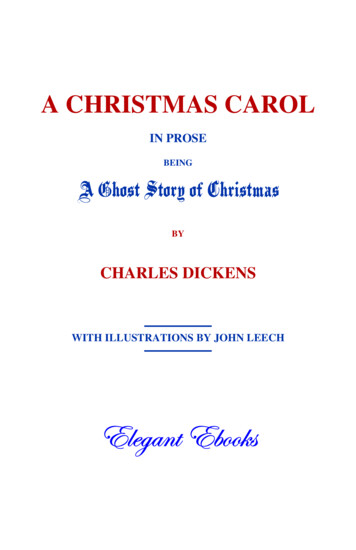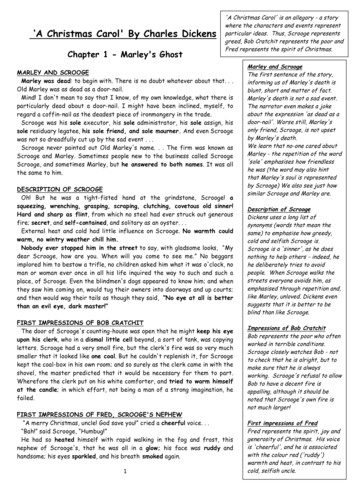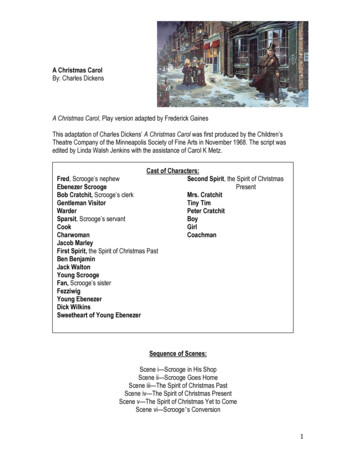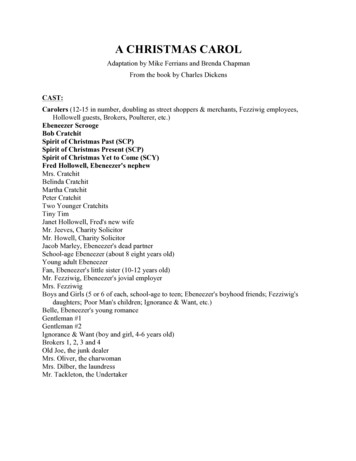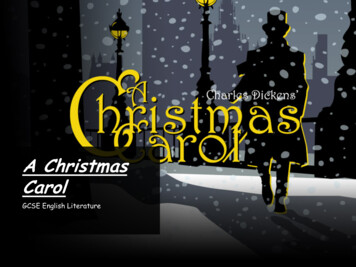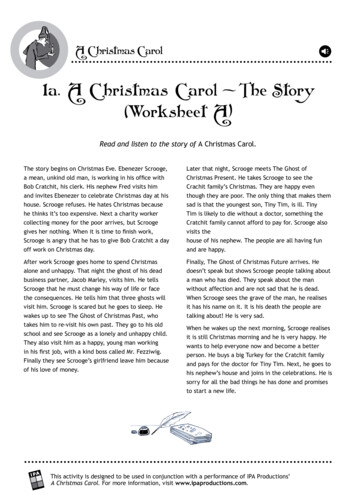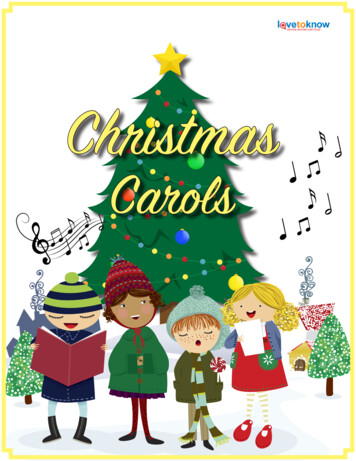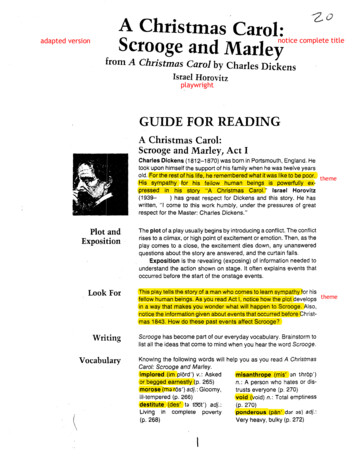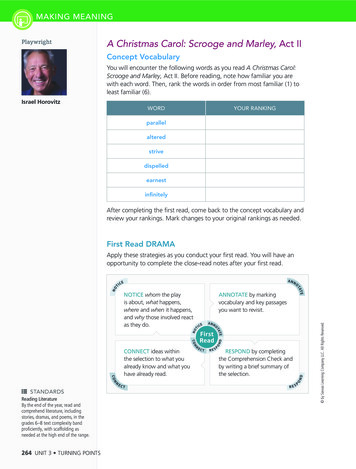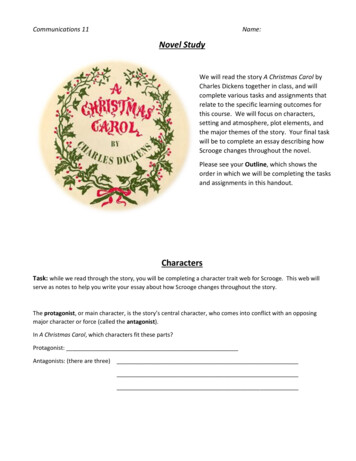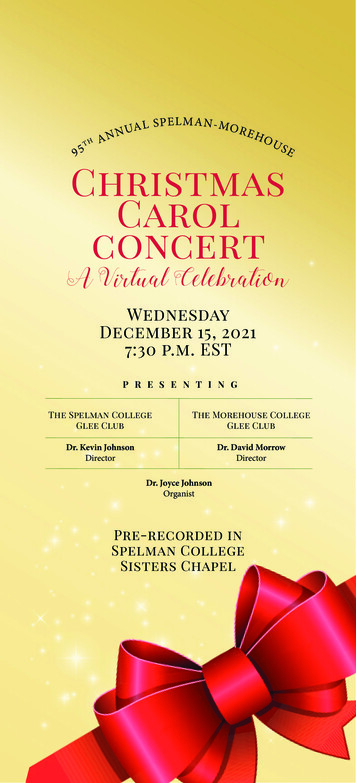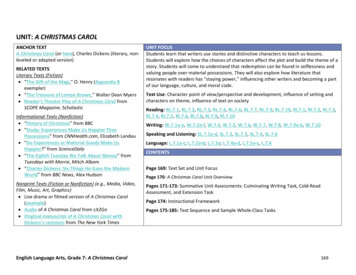
Transcription
UNIT: A CHRISTMAS CAROLANCHOR TEXTA Christmas Carol (or here), Charles Dickens (literary, nonleveled or adapted version)RELATED TEXTSLiterary Texts (Fiction) “The Gift of the Magi,” O. Henry (Appendix Bexemplar) “The Treasure of Lemon Brown,” Walter Dean Myers Reader’s Theater Play of A Christmas Carol fromSCOPE Magazine, ScholasticInformational Texts (Nonfiction) “History of Christmas” from BBC “Study: Experiences Make Us Happier ThanPossessions” from CNNHealth.com, Elizabeth Landau “Do Experiences or Material Goods Make UsHappier?” from ScienceDaily “The Eighth Tuesday We Talk About Money” fromTuesdays with Morrie, Mitch Albom “Charles Dickens: Six Things He Gave the ModernWorld” from BBC News, Alex HudsonNonprint Texts (Fiction or Nonfiction) (e.g., Media, Video,Film, Music, Art, Graphics) Live drama or filmed version of A Christmas Carol(example) Audio of A Christmas Carol from Lit2Go Original manuscript of A Christmas Carol withDickens’s revisions from The New York TimesEnglish Language Arts, Grade 7: A Christmas CarolUNIT FOCUSStudents learn that writers use stories and distinctive characters to teach us lessons.Students will explore how the choices of characters affect the plot and build the theme of astory. Students will come to understand that redemption can be found in selflessness andvaluing people over material possessions. They will also explore how literature thatresonates with readers has “staying power,” influencing other writers and becoming a partof our language, culture, and moral code.Text Use: Character point of view/perspective and development, influence of setting andcharacters on theme, influence of text on societyReading: RL.7.1, RL.7.2, RL.7.3, RL.7.4, RL.7.6, RL.7.7, RL.7.9, RL.7.10, RI.7.1, RI.7.2, RI.7.3,RI.7.4, RI.7.5, RI.7.6, RI.7.8, RI.7.9, RI.7.10Writing: W.7.1a-e, W.7.2a-f, W.7.4, W.7.5, W.7.6, W.7.7, W.7.8, W.7.9a-b, W.7.10Speaking and Listening: SL.7.1a-d, SL.7.2, SL.7.3, SL.7.4, SL.7.6Language: L.7.1a-c; L.7.2a-b; L.7.3a; L.7.4a-d, L.7.5a-c, L.7.6CONTENTSPage 169: Text Set and Unit FocusPage 170: A Christmas Carol Unit OverviewPages 171-173: Summative Unit Assessments: Culminating Writing Task, Cold-ReadAssessment, and Extension TaskPage 174: Instructional FrameworkPages 175-185: Text Sequence and Sample Whole-Class Tasks169
A Christmas Carol Unit OverviewUnit Focus Topic: Self-reflection andselflessnessThemes: Explore howcharacters teach life lessons andachieve redemption throughselflessness and valuingpeople over materialpossessionsText Use: Character point ofview/perspective anddevelopment, influence ofsetting and characters ontheme, influence of text onsocietyDaily TasksSummative Unit AssessmentsA culminating writing task: How authors develop contrastingpoints of view/perspectivesThe influences of characters andsetting on themeA cold-read assessment: Reading and understanding gradelevel textsComparing and contrasting howtexts approach similar topicsUnderstanding academicvocabularyAn extension task: Influence of text on other texts,social traditions, and languageDaily instruction helps students read and understand textand express that understanding. English Language Arts, Grade 7: A Christmas CarolLesson 1: Stave I of A Christmas Carol (sample tasks)Lesson 2: “The Treasure of Lemon Brown” (sample tasks)Lesson 3: “History of Christmas,” Stave II and Stave III of AChristmas Carol (sample tasks)Lesson 4: Stave IV of A Christmas Carol (sample tasks)Lesson 5: “Study: Experiences Make Us Happier ThanPossessions” and “Do Experiences or Material GoodsMake Us Happier?”Lesson 6: Stave V of A Christmas Carol and “The Gift ofthe Magi”Lesson 7: Reader’s Theater Play of A Christmas Carol fromSCOPE Magazine and A Christmas CarolLesson 8: “The Eighth Tuesday We Talk About Money”from Tuesdays with Morrie (cold-read assessment)Lesson 9: Original manuscript of A Christmas Carol withDickens’s revisions (sample tasks and culminating writingtask)Lesson 10: “Charles Dickens: Six Things He Gave theModern World” (extension task)170
SUMMATIVE UNIT ASSESSMENTSCULMINATING WRITING TASK1Throughout A Christmas Carol Charles Dickens introduces different points of view regarding a man’s “business.” Scrooge is described as being a man of“business,” and in Stave I, Marley’s ghost says, “Mankind was my business.” What does Dickens want us to understand about the “business” of being human?(RL.7.2, RL.7.3, RL.7.6) Write a multi-paragraph essay that introduces a claim about what Dickens wants us to understand and supports the claim with reasoningand relevant evidence that acknowledges the points of view of the characters and analyzes how Dickens develops his ideas over the course of the text. (RL.7.1;W.7.1a, b, e; W.7.9a; W.7.10)Teacher Note: The writing should use grade-appropriate words and phrases, as well as a variety of sentence patterns, choosing among simple, compound,complex, and compound-complex sentences. It should also demonstrate command of proper grammar and usage, punctuation, and spelling. (W.7.1c, d; L.7.1b;L.7.2a-b; L.7.3a; L.7.6) Use peer and teacher conferencing as well as small-group work that targets student weaknesses in writing to improve student writingability. (W.7.4, W.7.5)Handouts to support students in rereading closely to determine meaning surrounding this question and an evidence organizer for this question can be accessedhere.2UNIT FOCUSWhat should students learn from the texts? Topic: Self-reflection and selflessness Themes: Explore how characters teach lifelessons and achieve redemption throughselflessness and valuing people overmaterial possessions Text Use: Character point ofview/perspective and development,influence of setting and characters ontheme, influence of text on society12UNIT ASSESSMENTDAILY TASKSWhat shows students have learned it?This task assesses:Which tasks help students learn it?Read and understand text: How authors develop contrasting points ofview/perspectivesThe influences of characters and setting onthemeLesson 1 (sample tasks included)Lesson 2 (sample tasks included)Lesson 4 (sample tasks included)Express understanding of text: Lesson 6Lesson 9 (use this task)Culminating Writing Task: Students express their final understanding of the anchor text and demonstrate meeting the expectations of the standards through a written English Language Arts, Grade 7: A Christmas Carol171
COLD-READ ASSESSMENT3Read “The Eighth Tuesday We Talk About Money” independently (RI.7.10) and answer a combination of multiple-choice and constructed-response questions4about the text and in comparison to other texts in the unit, using evidence for all answers. Sample questions:1. How does Morrie support the following idea: “These were people so hungry for love that they were accepting substitutes”? (RI.7.4, RI.7.5, RI.7.8)2. Identify two central ideas of this text and analyze how they are developed. (RI.7.1, RI.7.2, W.7.9b, W.7.10)3. What does Morrie believe about money? How does Albom develop Morrie’s point of view? How does Albom distinguish Morrie’s point of view from hisown and those of others? Cite textual evidence as support. (RI.7.1, RI.7.2, RI.7.6, RI.7.8, W.7.9b)4. According to Morrie, “We put our values in the wrong things. And it leads to very disillusioned lives.” Explain what Morrie means by explaining how acharacter in A Christmas Carol and one of the short stories is disillusioned by valuing the wrong thing. (RL.7.2, RL.7.4, RI.7.2, RI.7.4, RI.7.9, W.7.9a-b,W.7.10, L.7.6)UNIT FOCUSWhat should students learn from the texts? Topic: Self-reflection and selflessness Themes: Explore how characters teach lifelessons and achieve redemption throughselflessness and valuing people overmaterial possessions Text Use: Character point ofview/perspective and development,influence of setting and characters ontheme, influence of text on societyUNIT ASSESSMENTDAILY TASKSWhat shows students have learned it?This task focuses on:Which tasks help students learn it?Read and understand text: Reading and understanding grade-leveltextsComparing and contrasting how textsapproach similar topicsUnderstanding academic vocabularyLesson 1 (sample tasks included)Lesson 2 (sample tasks included)Express understanding of text: Lesson 6Lesson 8 (use this task)3Cold-Read Assessment: Students read a text or texts independently and answer a series of multiple-choice and constructed-response questions. While the text(s) relate to the unit focus, thetext(s) have been taught during the unit. Additional assessment guidance is available at ear-assessments.4Ensure that students have access to the complete texts as they are testing.English Language Arts, Grade 7: A Christmas Carol172
EXTENSION TASK5How has Charles Dickens influenced modern society? Have students research:(1) references and adaptations to his works (including allusions to his works and ideas);(2) the effect of A Christmas Carol on our modern Christmas traditions; and(3) the words, phrases, and character types that have been introduced into our language through Dickens’s work. (RL.7.9, W.7.7, W.7.8, L.7.5a)Then students create a written report that explains how Dickens influenced modern society, including sufficient relevant evidence. (RI.7.1, W.7.2, W.7.9b,W.7.10) Conduct a student-led classroom discussion about the research, emphasizing findings and evidence gathered for the report. (SL.7.1c, d; SL.7.4; SL.7.6)Articles to support research: “Charles Dickens: Six Things He Gave the Modern World” from BBC News, Alex Hudson; and “History of Christmas” from BBCTeacher Note: The report introduces and develops the topic with relevant facts, details, examples, or quotations and includes organizational strategies,formatting, and graphics, when useful to aid comprehension. (W.7.2a, b, c, f; W.7.9b) The report uses precise grade-appropriate words and phrases andmaintains a formal style with a variety of sentence patterns, including simple, compound, complex, and compound-complex sentences, to signal differingrelationships among ideas. Student writing demonstrates command of proper grammar and usage, punctuation, and spelling. Have students use technology toproduce a report, offer suggestions on a peer’s writing, and publish the report. (W.7.2d, e; W.7.6; L.7.1b; L.7.2a-b; L.7.3; L.7.6) Use peer and teacherconferencing as well as small-group work that targets student weaknesses in writing to improve student writing ability. (W.7.4, W.7.5)UNIT FOCUSWhat should students learn from the texts? Topic: Self-reflection and selflessness Themes: Explore how characters teach lifelessons and achieve redemption throughselflessness and valuing people overmaterial possessions Text Use: Character point ofview/perspective and development,influence of setting and characters ontheme, influence of text on society5UNIT ASSESSMENTDAILY TASKSWhat shows students have learned it?This task focuses on:What tasks help students learn it?Read and understand the text: Influence of text on other texts, socialtraditions, and our languageLesson 3 (sample tasks included)Lesson 7Express understanding of text: Lesson 10 (use this task)Extension Task: Students connect and extend their knowledge learned through texts in the unit to engage in research or writing. The research extension task extends the concepts studied in theset so students can gain more information about concepts or topics that interest them. The writing extension task either connects several of the texts together or is a narrative task related to theunit focus.English Language Arts, Grade 7: A Christmas Carol173
INSTRUCTIONAL FRAMEWORKIn English language arts (ELA), students must learn to read, understand, and write and speak about grade-level texts independently. To do this, teachers must selectappropriate texts and use those texts so students meet the standards, as demonstrated through ongoing assessments. To support students in developing independencewith reading and communicating about complex texts, teachers should incorporate the following interconnected components into their instruction.Click here6 to locate additional information about this interactive framework.Whole-Class InstructionThis time is for grade-level instruction. Regardless of a student’s reading level, exposure to grade-leveltexts supports language and comprehension development necessary for continual reading growth. Thisplan presents sample whole-class tasks to represent how standards might be met at this grade level.Small-Group ReadingThis time is for supporting student needs that cannot be met during whole-class instruction. Teachersmight provide:1. intervention for students below grade level using texts at their reading level;2. instruction for different learners using grade-level texts to support whole-class instruction;3. extension for advanced readers using challenging texts.Small-Group WritingMost writing instruction is likely to occur during whole-class time. This time is for supporting studentneeds that cannot be met during whole-class instruction. Teachers might provide:1. intervention for students below grade level;2. instruction for different learners to support whole-class instruction and meet grade-level writingstandards;3. extension for advanced writers.Independent ReadingThis time is for increasing the volume and range of reading that cannot be achieved through other instruction but is necessary for student growth. Teachers can:1. support growing reading ability by allowing students to read books at their reading level; and2. encourage reading enjoyment and build reading stamina and perseverance by allowing students to select their own texts in addition to teacher-selected lesson-assessment-planning-resourcesEnglish Language Arts, Grade 7: A Christmas Carol174
TEXT SEQUENCE AND SAMPLE WHOLE-CLASS TASKSTEXT SEQUENCELESSON 1:7TEXT USETEXT DESCRIPTION: Stave I establishes the setting and resulting mood through Dickens’ use of descriptive language(RL.7.3). Many of the main characters are introduced and developed, including the greedy Scrooge.Stave I of A Christmas Carol,Charles DickensTEXT FOCUS: This section of the text prepares the reader to study Scrooge as a character, take note of his changes, andthen draw conclusions about how those changes develop a theme (RL.7.2, RL.7.3).UNIT TASKS NOTE: Throughout the unit have students maintain a reading log in which they record brief quotations thatshow Scrooge’s character development over the course of the play. (RL.7.1) In the log, students should include:(1) specific quotations from the text;(2) brief objective summaries to provide context for the quotations/paraphrases; and(3) an analysis of the impact of the phrases used.Students should indicate when Scrooge is interacting with new characters or ghosts in their notes so that later they canreflect on the impact each interaction had on the development of Scrooge’s character. (RL.7.1, RL.7.2, RL.7.3, RL.7.4,L.7.5a-c)MODEL TASKSLESSON OVERVIEW: Students read the text as a group and explore the vocabulary of the text through word mapping.Students then work in pairs to annotate the text to explore Scrooge’s character and the setting and mood of the text.Students share their annotations and end the lesson discussing who Scrooge is and how he is responding to the setting.READ THE TEXT:78 The complex vocabulary and sentence structure of A Christmas Carol will be difficult for students to understand.Have students read, reread, and analyze the language with support. Read aloud the first part of this text studentsfollow along, and then have them work in pairs or collaborative groups to reread and analyze the text. As a class, choose two or three words from Stave I of A Christmas Carol (e.g., dismal, morose, cross, indignantly,resolute, scarcely, caustic, faltered, spectre, restless, haste). Define the words in context and verify the meanings.(RL.7.4; L.7.4a, d) Then have student pairs analyze the words through semantic mapping.8 (L.7.4b, c; L.7.5b, c)Have students display their maps for other students in class to reference.Note: One lesson does not equal one day. Teachers should determine how long to take on a given lesson. This will depend on each unique lish Language Arts, Grade 7: A Christmas Carol175
TEXT SEQUENCETEXT USE Note for Small-Group Reading: Teachers may choose to engage struggling readers with additional readings of thetexts before or after reading them as a whole class. This will provide extra time for students to process theinformation. This can help students to be more prepared to participate in whole-class discussion. For example,with a small group of students, reread the most complex passages from the anchor text while viewingillustrations9 that accompany the passage. This can help students visualize as they are reading the text. Followthis by breaking down the most complex sentences in the passage to understand how the different phrases worktogether to develop meaning. (L.7.1a, b) In Stave I, students who are struggling to understand the text and imagesused to describe Scrooge could reread those sections, view an image of Scrooge, and then analyze specificphrases in the text, drawing comparisons between what the text says and what the drawing depicts.UNDERSTAND THE TEXT: Have students work independently or in pairs to reread the sections of Stave I in which Scrooge is introduced andinteracts with other characters. Annotate the text10 by highlighting, underlining, or circling the words, phrases,and images used to describe Scrooge (both his physical appearance and his personality). (RL.7.1, RL.7.4, L.7.5a)Share observations and annotations with the class to ensure that students are focusing on the right sections ofthe text and making valid annotations. Divide students into groups and assign each group a particular section (oneor two paragraphs). Have each group analyze the text and create a “mega-annotation” by pasting a large printedversion of each assigned section on poster paper and directing the groups to add annotations that explain howthe language develops Scrooge’s character (RL.7.1; RL.7.4; L.7.5a, c; SL.7.1a) Have the groups perform a gallery walk11 in which they examine the other groups’ annotations and consider thefollowing question: How do words and phrases help you, as a reader, to understand Scrooge as a character?Students provide feedback, ask questions, and suggest additional annotations on sticky notes or by writingdirectly on the annotations. (SL.7.3) In pairs, students reread Stave I and answer the following questions in their notes:oWhat was the relationship between Marley and Scrooge? Why does Dickens repeat “sole” six times in a singlesentence in the second paragraph of the text?oWhat is meant by the phrase “he was an excellent man of business on the very day of the cts/english/a christmas carol/audio clips/episode walk10English Language Arts, Grade 7: A Christmas Carol176
TEXT SEQUENCEo 12TEXT USEWhat is the significance of mentioning the size of Scrooge’s fire in comparison to the clerk’s fire in paragraph10? What does this detail reveal about Scrooge?oWhat is Scrooge’s nephew’s reason for considering it a merry Christmas? What did the two men who enteredScrooge’s office after his nephew left want? How does Scrooge respond?oWhat does the phrase, “I can’t afford to make idle people merry” reveal about Scrooge?oSummarize what Marley’s ghost tells Scrooge about the afterlife. Scrooge responds, “‘But you were always agood man of business, Jacob.’” What does this reveal about what Scrooge values? How does that contradictwhat the ghost indicates was his real business?o“‘Without their visits,’ said [Marley’s] Ghost, ‘you cannot hope to shun the path I tread.’” What is meant bythis statement?Then conduct a Socratic seminar12 focused on the following questions: The word “business” is repeated severaltimes throughout Stave I. How is “business” used differently throughout the text? (RL.7.4) What are the differentpoints of views regarding “business”? How does Dickens develop and contrast those points of view? (RL.7.6)Marley’s ghost says to Scrooge, “Mankind was my business. The common welfare was my business; charity,mercy, forbearance, and benevolence, were, all, my business. The dealings of my trade were but a drop of waterin the comprehensive ocean of my business!” How are the lessons and characters in A Christmas Carol a story ofmankind? (RL.7.2) Have students work in pairs to form their arguments about each question. The pairs should beprepared with quotes from the text to support their claims and should use their notes from previous lessons.(SL.7.1a) Then engage the full class in a discussion (Socratic seminar) on the questions. Students should presenttheir claims and evidence. Students should respond to other claims made and express how their opinions arechanging given the arguments of others (citing evidence from the text). (SL.7.1b, c, d; SL.7.3) Students should beable to explain how the ideas presented in the discussion support the discussion questions and locate additionalevidence that supports or contradicts the claims presented. (RL.7.1, SL.7.2) After the discussion, have students goback to their pairs to review their initial claims and evidence given what was presented from others during theclass ssEnglish Language Arts, Grade 7: A Christmas Carol177
TEXT SEQUENCETEXT USEEXPRESS UNDERSTANDING: LESSON 2:“The Treasure of Lemon Brown,”Walter Dean MyersLastly, have students independently reread paragraph 9 (“Once upon a time—of all the good days in the year, onChristmas Eve ”) and the paragraph beginning with “Meanwhile the fog ” through “Now, it is a fact, that therewas nothing at all particular about the knocker ” (paragraphs 65-77) and annotate the text.13 Focus studentannotations on the words, phrases, and images used to describe the time and place of the story. Using a graphicorganizer, students should record the words, phrases, and images in column one. (RL.7.1, RL.7.4) In the secondcolumn, have students work with a partner to determine the setting of the story based on the language they haveidentified. In the third column, have students express the feelings that are associated with that setting. (L.7.5c)Underneath the graphic organizer, have students answer the following questions: What emotions or feelings doyou normally have about Christmas? How are Scrooge’s feelings different? What might be the author’s purposefor emphasizing a setting and character that are so “cold” and hostile at the beginning of the story? (RL.7.2,RL.7.3)TEXT DESCRIPTION: “The Treasure of Lemon Brown” details Greg Ridley’s chance encounter with Lemon Brown, ahomeless former blues performer. Through their brief interaction, Lemon is able to teach Greg a thing or two about life,thus changing Greg’s outlook on his sometimes tumultuous relationship with his father.TEXT FOCUS: This text helps students explore how authors develop contrasting character points of view and themes.“The Treasure of Lemon Brown” shares similar themes with the anchor text, mainly defining “treasure” as somethingmore than material possessions. The structure of this story is also similar to the anchor text in that the setting reflects thecharacters’ decisions. Greg’s change in attitude over the course of the text contributes to the development of a theme.Lemon, similar to the ghosts that visit Scrooge, shares a different point of view from Greg, which allows Greg to see hismistakes and learn something in the process. (RL.7.6) This text is best used for independent reading using Notice andNote signposts.14,15MODEL TASKSSAMPLE TASK: Access questions, vocabulary, a writing task, and a student exemplar16 for “The Treasure of “The Treasure of Lemon Brown” contains several signposts (e.g., contrasts and contradictions, memory moment, words of the wiser, and tough questions). Using the Notice and Note strategy canhelp students develop into more purposeful English Language Arts, Grade 7: A Christmas Carol178
TEXT SEQUENCELESSON 3:“History of Christmas” from BBCStave II and Stave III of A ChristmasCarol, Charles DickensTEXT USETEXT DESCRIPTION: “History of Christmas” details the influences on and history of modern Christmas traditions.Scrooge is greeted in Staves II and III by the first two of the three ghosts of Christmas spirit. In these meetings Scroogereflects on his life and reconsiders his values.TEXT FOCUS: Students use the article from BBC about the history of Christmas to compare the historical account to afictional account. (RL.7.9) This comparison will help them discuss how and why Dickens chose Christmas as the setting forhis novel and the impact of this decision on the characters (RL.7.3) and the meaning of the text. (RL.7.2) Note: The“History of Christmas” can also be used to support the Extension Task (Lesson 10). Students also explore how thecontrasts between Scrooge’s point of view and those of other characters lead to the development of a theme. (RL.7.2,RL.7.6)MODEL TASKSLESSON OVERVIEW: Students read the text in pairs and explore the vocabulary of the text through word mapping.Students compare “History of Christmas” to the setting of Christmas in A Christmas Carol. Students continue to track theactions of Scrooge and the development of his character. In writing, students contrast Scrooge’s personal reflections withthe setting of Victorian Christmas.READ THE TEXTS: Have students read “History of Christmas” independently prior to analyzing the text in pairs. They should selecttwo or three words from “History of Christmas,” such as hardly, transformation/transformed, reminiscent,commissioned, accessible, sentiment, uniformity, synthetic, modest, echelons, revived, popularized, cultivating,encapsulate. To increase the words studied, assign students different words. Have students define the words incontext and verify the meanings. (RI.7.4; L.7.4a, d) Then analyze the words through semantic mapping17 (i.e.,verify their part of speech, identify how Greek or Latin affixes and roots provide clues to the words’ meaning, andrecognize the relationship between the words and their associations). (L.7.4b, c; L.7.5b, c) Have students displaytheir maps for other students in class to reference. 17Read aloud Stave II as students follow along and summarize the stave as a class. (RL.7.2) Divide the students intopairs and have them partner-read the first 20 paragraphs of Stave II aloud. Ask students to take note of Dickens’slanguage at the beginning of Stave II by circling or highlighting the repeated text and sound devices. Discuss thefollowing as a class: What is the effect of repetition and sound devices in first part of Stave II? How does Dickensbuild suspense in the first part of this chapter? (RL.7.1, glish Language Arts, Grade 7: A Christmas Carol179
TEXT SEQUENCE TEXT USEHave students read Stave III in pairs and summarize the text. (RL.7.2, RL.7.10). Assign each pair a differentparagraph that contains descriptive language and various clauses and phrases (e.g., paragraph 4 of “History ofChristmas,” paragraph 5 of Stave II, paragraph 8 of Stave III). Prompt students to select two or three sentencesfrom the paragraph. Students should then divide the sentences into chunks. For example:o“By the 1880s/the sending of cards/had become hugely popular,/creating a lucrative industry/thatproduced 11.5 million cards/in 1880 alone” (from “History of Christmas”)o“The idea/being an alarming one,/he scrambled/out of bed,/and groped his way/to the window” (fromStave II)o“Its feet,/observable/beneath the ample folds of the garment,/were also bare;/and on its head/it wore noother covering/than a holly wreath,/set here and there/with shining icicles” (from Stave III) Have students discuss the function of each phrase, explaining how each contributes to meaning of the overallsentence. (L.7.1a) Ask students to select a phrase (prepositional, noun, or verbal) from the chunked sentence toimitate and incorporate the sentence structure into their writing in the final writing task of this lesson. (L.7.1c) Note for Small-Group Reading: If students struggle to understand A Christmas Carol, support them by readingadditional texts that provide necessary background knowledge that cannot be learned through the anchor text.Do not provide a lower level of the anchor text. Example texts: The Bible contains several short passages aboutthe value of material possessions (e.g., Ecclesiastes 2:4-1118 or Matthew 6:19-3119); select other texts (as needed)that explain cultural elements specific to Victorian England that are alluded to but not explained.UNDERSTAND THE TEXTS: 1819Have students analyze the s
English Language Arts, Grade 7: A Christmas Carol 172 COLD-READ ASSESSMENT3 Read The Eighth Tuesday We Talk About Money _ independently (RI.7.10) and answer a combination of multiple-choice and constructed-response questions4 about the text and in comparison to
